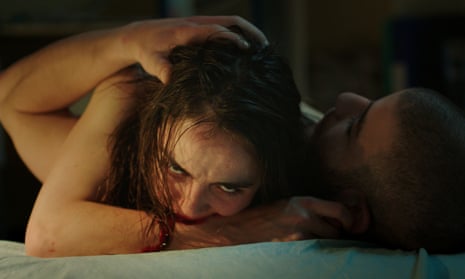We’ve had our fill of teenage vampires. We’ve had teenage werewolves, teenage witches, teenage zombies, teenage telekinetics, teenage serial killers and even a possessed teenage hand. In recent years, though, we’ve been introduced to the teenage cannibal – whose arrival culminates with Bones and All, a nicely poignant film about adolescence, belonging and the compulsion to eat human flesh.
The idea of fusing the coming-of-age movie with the grisly subgenre of cannibal-horror might sound outlandish on the face of it but it will be entirely familiar to anyone who saw Raw, Julia Ducournau’s film about an angsty medical student, or Yellowjackets, the hit HBO drama about a high-school football team who crash-land in the forest.
Mixing extreme gore with heartfelt sentiment, all three are stories of lost souls in hostile new surroundings. The same could be said for The Neon Demon, Nicolas Winding Refn’s lurid send-up of the LA fashion scene featuring necrophilia and regurgitated eyeballs, and Ana Lily Amirpour’s dystopian drama The Bad Batch, which kicks off with our hero being exiled to the desert and dismembered with a chainsaw.
Both came out in 2016, a year after The Lure, which could well be the best operatic Polish musical about flesh-eating mermaids ever made. And earlier this year we got Fresh, which put Daisy Edgar-Jones at the mercy of a murderous hidden-market butcher to satirise the modern dating scene.
All these tales of elegantly disaffected youth are a far cry from the genre’s inception, which came with a slew of similarly plotted Italian films in the late 70s and 80s that invariably depicted the cannibal as part of a far-flung tribe. With budgets low and splatter content high, these were proudly degenerate films that made sure to feature the C-word in their title and wore their viewers’ disgusted reactions as a badge of pride.
Last Cannibal World was seized and confiscated in the UK under the Obscene Publications Act. Cannibal Ferox opened with a title card warning viewers about the “barbaric torture and repulsive subject matter” to come, and forged a marketing campaign on the claim that it had been banned in 31 countries. Cannibal Holocaust did one better: its then-novel “found footage” structure led to the director being hauled up on murder charges, eventually forced to bring his actors into court to prove they were still alive.

And yet, even back then, films about people eating one another were smuggling in weighty themes behind the grotesque facade. In among the severed genitals and impaled virgins of Cannibal Holocaust are the makings of a study in journalistic ethics. Look beyond Cannibal Ferox’s charred corpses and – again – severed genitals, and you might see a horrifying critique of western imperialism.
Quite how much political subtext there was to their American counterparts – which tended to be straightforward blood-and-guts slashers – is up for debate, although plenty of people will tell you that The Texas Chainsaw Massacre is a fable about the consequences of industrial capitalism, or that The Hills Have Eyes is a rebuke to bourgeois America.
Either way, any lofty pretensions the films might have harboured were certainly kept quiet by their publicists. This was the “video nasty” era, when marketing execs – spurred on by the moral panic over graphic violence flooding the shelves of Blockbuster – made sure to hype up these movies’ most visceral qualities. The video case for Anthropophagus: The Beast showed a man gorging on raw intestines with the tagline “It’s not fear that tears you apart … it’s him!” You didn’t rent a cannibal film for its soulful drama.
So when exactly did the screen cannibal grow a heart? Perhaps the process started in the early 90s, when Gen-X icon Ethan Hawke was cast in Alive, the harrowing true-life story of a rugby team forced to survive after crashing in the Andes, and The Silence of the Lambs brought us cinema’s most celebrated cannibal: an art-loving, wine-swilling intellectual.

That film’s clean sweep of major Oscars brought the flesh-eater definitively into the mainstream. By the time the new millennium came around, and its sequel had doubled down on the depiction of Hannibal Lecter as an eloquently seductive antihero, the cannibal’s admission to polite society was complete.
Not content with leading Hollywood blockbusters, the cannibal quickly set about infiltrating the art house. A few months after Hannibal came Trouble Every Day, Clare Denis’ blood-drenched existentialist drama set in the well-heeled world of Parisian neuroscientists, and the following year In My Skin, another French gut-wrencher which mixed things up by having its protagonist tucking into her own flesh.
It is only recently, though, that the cannibal has started to pop up in the coming-of-age movie. And given that adolescence is a time of violent outbursts and confusing carnal urges, maybe it’s a surprise it took this long. There’s been another notable change. The protagonists of Bones and All, Raw, The Neon Demon, The Bad Batch and Yellowjackets are all young women. It turns out girls can have depraved cravings too.
Having gone from villain to antihero, the cannibal has now become a fully sympathetic dramatic lead. Today she is a victim of harsh social pressures in films that use bloody body horror as a symbol for primal human struggles. Or as Yellowjackets creator Bart Nickerson says: “What portion of our revulsion to these things is a fear of the ecstasy of them?”
Director Luca Guadagnino meanwhile has described Bones and All as “an extremely romantic movie, addressing the romanticism that lies within”.
He’s not wrong – but who’d have thought the cannibal movie would ever become this tender, this tasteful? And more to the point: can you stomach it?

Comments (…)
Sign in or create your Guardian account to join the discussion